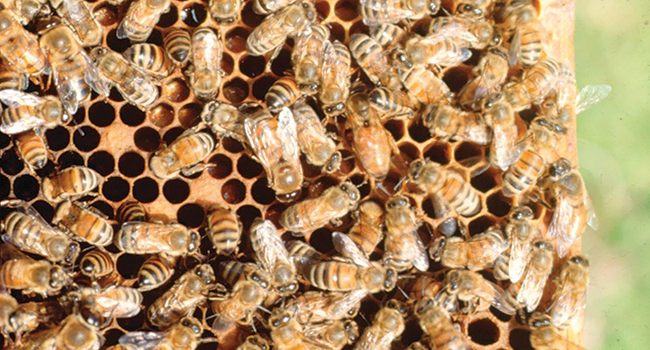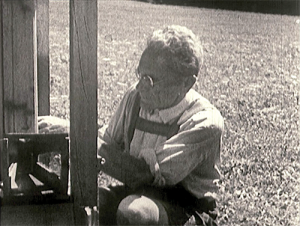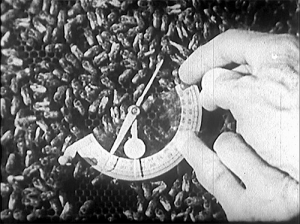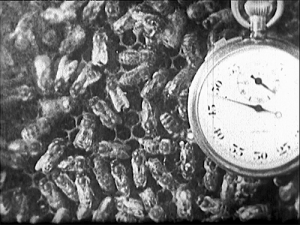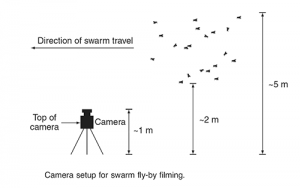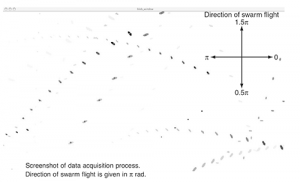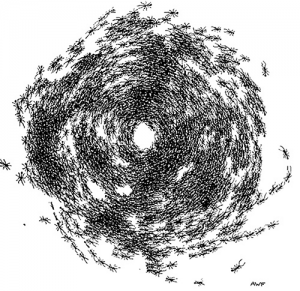By: Peter Borst
Like a lot of beekeepers, I have a pretty extensive collection of books about bees.
They range all the way from the ABC of Bee Culture to Zoosemiotics – what the heck is that? Semiotics is the study of signs and their meaning; “Zoo-” refers to animals. So, it is animal communication through signs. The root sema is found in the word semaphore, which is a method of signaling with flags. Root states this about bees in his ABC of Bee Culture:
Of course, they have particular notes, as of joy, sorrow, anger, despair, etc., which are produced by the wings, usually when on the wing, but I am quite sure they are unable to communicate to each other more than a single idea (Root, 1882).
But signaling with flags can hardly convey much more than one idea at a time, so we can see that even the use of very basic symbols is a form of communication.
Most students of biology are familiar with the honey bee dance, and how it encodes quite a bit of information about the location of nectar sources. In this article I will only touch upon it; for more in depth discussion I shall defer to the excellent books on the topic, especially those by Karl von Frisch. He won a Nobel Prize for his discoveries related to the exquisite method honey bees use to indicate the distance, direction and value of a nectar source. Later researchers learned that the honey bee scouts also use this dance to tell their nest mates information about potential nest sites.
Briefly, Karl von Frisch observed that honey bees have a peculiar sort of dance that they perform at certain times of the year. It is especially noticeable during nectar flows, which gave a clue to its meaning. Spending countless hours watching the bees in glass sided hives, he began to see more clues emerge. Simply described, the dancing consists of a figure eight pattern, and von Frisch realized the orientation gradually shifted every day from morning to dusk. That is how he came to understand that the honey bees were giving a direction by referencing the sun. If the patch of flowers is toward the sun’s position, they point upward. As the sun moves across the sky they include the angle of deviation from “towards the sun.” As the sun moves east to west, the angle gradually shifts, because the sun is moving to the west of the destination.
- Measuring the angle of the dance run.
- Timing the dances.
Many volumes have been written about this. Are bees actually communicating, or is this just an instinctive mechanism of system control, like some sort of GPS device? Does it really matter if the honey bee is aware of what it is doing, when it dances? We are not continually aware of ourselves when we are communicating, especially in the middle of an intense discussion. When the message is urgent, only one thing matters: communicating clearly and directly. It also doesn’t matter whether the receivers “understand” the message. What matters is that they are able to get the information and act appropriately. So from this standpoint, the honey bee dance certainly qualifies as a means of gathering information, packaging it into symbols, and generating an appropriate response in the recipients. The foragers tell their mates where the nectar is, and they go there. This symbolic communication among animals is zoosemiotics. Dario Martinelli states:
The dance of the honey bee is a sign of something that the other bees cannot see, but do know as an entity, and this entity is abstractly, yet clearly, represented in their minds.
Communication, signification, representation are all zoological phenomena, rather than simply anthropological ones. Therefore: what is really communication? What is signification? Where do they come from? What are the behavioural processes implied in their production? All these questions (and attempts to answer them) are good. (Martinelli, 2010).
Since the discovery that the honey bee dance encodes navigational information, there have been attempts to refute the idea that bees use this dance to locate food sources. Some claimed that bees use only the scent of nectar on scouts to locate floral sources. Nevertheless, honey bees also perform this dance on the surface of bee swarms that have not yet moved to a permanent home, and these dances indicate the location of potential home sites.
Good Vibrations
I will not be discussing chemical communication in this article. For recent information, I recommend the exemplary article on pheromones by Dr. Christina Grozinger, in the recent edition of The Hive and The Honey Bee. And, chemical communication is more like a regulatory system and does not make use of symbols, or overt behaviors.
Instead, I will focus on messaging where an individual bee communicates an idea to one or more other bees by the use of physical behavior; body language, if you will. One of the interesting features of social insect groups is the dominance hierarchy. Investigators have learned that wasps are able to physically assert dominance over their nest mates. This is an example of a single idea: “I am the boss here, you are not.” The dominant wasp behaves aggressively toward her nest mates: moving in a “menacing” fashion, tapping them vigorously on the eyes with their antennae, even biting them on the eyes, face and legs (Pardi, 1948).
In the honey bee colony, a simple and direct method of communication is the vibration or “shaking” signal.
An example of a modulatory signal is the vibration signal of the honey bee, which consists of a worker rapidly vibrating her body dorso-ventrally for one to two seconds, usually while grasping a recipient with her forelegs. Vibrating bees typically roam over large areas of the nest and produce a series of signals (up to 20 or more per min) that last from several minutes to over an hour (Schneider, 2004).
According to Schneider, shaking is a frequently used method of communicating in bee colonies, and is used in various ways and on many different types of bees including all ages of workers, virgin or laying queens and even on developing queens in their cells. Even so, he found that only about 13% of the hive bees ever use this means of communicating during their lifetime. The primary function of the vibration signal seems to be to motivate the receiving bees to increased activity, whatever they happen to be doing.
The Buzz Run
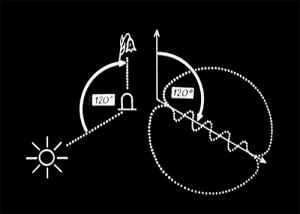 The social hymenoptera include certain bees, wasps and all of the ants. These insects live in colonies made up of hundreds or thousands of individuals. Many of their methods of communication are similar. For instance, wasps use what is called the “buzz run.”
The social hymenoptera include certain bees, wasps and all of the ants. These insects live in colonies made up of hundreds or thousands of individuals. Many of their methods of communication are similar. For instance, wasps use what is called the “buzz run.”
Reproductive swarming occurs when a portion of a colony leaves to produce a new colony – buzzing run activity may begin occurring at least a week prior to swarming. The scouts run excitedly with wings buzzing through groups of queens and younger wasps who are seen clustering in immobile, tight groups with their wings folded beneath their abdomens on the nest. Breaking runs disperse the clusters and often knock wasps from the nest surface (Forsyth, 1981).
This same buzz run takes place in honey bee colonies, prior to swarming. Martin Lindauer wrote about it, using very similar terminology as in the above about wasps:
It turned out that bees actually have their own signal for situations when the whole colony is to be alarmed simultaneously and quickly: it is a characteristic “buzz-running.” During this, the relevant bees very excitedly and nervously force themselves through between the other bees that are standing around. In an indirect zigzag-run they vigorously push the other bees aside, while strongly vibrating their abdomen, producing a clearly audible wing-buzzing (Lindauer, 1955).
The buzz run resembles the vibration signal but also incorporates the message that the activity is to take place outside of the nest. The bees are incited to action and ultimately begin to pour out of the hive in a great rush. Soon the air is filled with bees flying back and forth in great circles. The sight does not resemble a highly coordinated flock of starlings but rather, to us it appears quite chaotic. And yet, the teaming swarm soon begins to move, often for a great distance from the hive where they originated. There certainly seems to be some signal being generated which keeps the herd moving in a particular direction.
Streaker Bees
Early observers tended to assume that the queen was the leader of the swarm. The idea that the bees are controlled by the queen persisted among societies that had social hierarchies, usually with so-called royalty that demanded special privilege and power. Eventually, observers realized that the queen does not act as the director of hive activity. However, the discovery of powerful chemicals called pheromones led to the idea that the swarm could follow the scent of the queen. Later, Avitabile posited the idea that groups of workers could lead the swarming bees using some sort of odor cue. Christina Grozinger explains how this theory came to be refuted:
The hypothesis that workers produce an olfactory gradient to guide swarms has been rejected because swarms can navigate to their new home even if worker scent glands are sealed, preventing them from releasing such odors. Simulations suggest that knowledgeable house hunters could visually guide the uninformed masses by preferentially traveling in the direction of the new home (with all workers generally moving toward other workers, but avoiding collisions) or by making conspicuous and fast flights through swarms (with which naïve workers preferentially align themselves). Empirical studies of free-flying swarms show that workers do indeed “streak” above an airborne cloud of bees to visually indicate the direction of the new nest site and steer the swarm’s travel (Grozinger, 2014).
Martin Lindauer was the first to propose that there were bees guiding swarms by flying swiftly overhead and then circling back slowly along the side of the swarm. Tom Seeley and his colleagues were able to make use of video cameras and computer software to document the streaker bees. The guide bees flew over the swarm cloud creating visual cues pointing in the direction of the new home, the location of which had been already chosen.
They conducted interesting experiments to see if the swarms were actually following the streaker bees. Seeley’s work involves prepared swarms, which he then entices with bait hives. Typically, a swarm will fly more or less directly to their destination. He placed a swarm and a bait hive where it would have to cross the flight path of a small apiary. The bees in the apiary were flying back and forth from the hives to the distant flowers in the so called “bee-line.” When the swarm passed through the apiary’s bee lines, many of the swarming bees became confused, lost track of the streaker bees, and began following the bees going back and forth from the apiary. This essentially proved that the swarming bees were taking their cues from streaking bees.
The Bee’s Ears
People have long debated whether honey bees have some sort of ears, with which to hear sounds the way we do. Clearly, they have the other four senses: sight, touch, smell and taste. But do they hear?
In 1925, Kroning tested the auditory sense of bees with a siren. His extensive experiments lead him to the conclusion that, “Die Bienen konnten keine Tone wahrend des Fliegens horen, wohl aber in Marsch oder wahrend des Sitzens”
Roughly translated, this means: “The bees could hear no sound while flying, but they could while walking or sitting.” Most people are aware that honey bees as well as wasps are keenly sensitive to vibrations. And while our sense of hearing involves the action of vibrations on the eardrum, sensing sound through our hands or feet is not called hearing. Honey bees have no ears at all, if you are looking for something analogous to a mammalian ear. They are acutely sensitive to vibrations transmitted through substrates such as the combs and the hive itself.
The old tradition of banging pans to induce a honey bee swarm to alight is tied to the misconception than honey bees can “hear.” The banging of pans is probably linked to the beekeeper’s desire to alert the neighborhood to be on the look out for the swarm, and further to establish his or her ownership of it. In any case, Michael Smith showed that the practice of “tanging” simply doesn’t work, leaving us to conclude that bees either do not hear airborne sounds, – or they don’t pay any attention to them (Smith, 2013).
Another interesting vibration or sound produced by honey bees, is called “piping.”
It is frequently stated in books that the piping of the queen is “answered” by that of the queen nymphs. Herrod-Hempsall, for instance, in Beekeeping New and Old, describes the queen “stopping every few moments to pipe, the note being answered on each occasion by the imprisoned princess.” Was this answer a figure of speech, or did the nymphs definitely pipe each time in reply to the queen’s call? The point seems worthy of notice, because … this is the only case I can recall of positive evidence that bees can hear (Wallis, 1940).
In the case of these peculiar piping sounds of the queen, we really have no way of knowing whether the individuals are trying to communicate something, or if it is reflexive action, nor can we guess if the nest mates gain some meaning from the sounds. To us, it seems like a signal of some sort, but its importance is beyond our grasp. We have to guard against reading to much into the actions of the bees. I offer this example of going to far into the imagination:
Honey bee perception is highly emotional. This emotionality is manifested by characteristic subjective and objective symptoms. Due to this emotionality the primary form of bee consciousness may reflect different primordial affects – anxious, fear, rage, etc. (Lipiñski, 2006).
While it is true that beekeepers use these terms to describe their bees, we have no way of knowing whether honey bees feel anything like anger, sorrow or despair. It may appear that they do, but humans are prone to project feelings on to everything from their pets to the weather.
Fact or Fantasy?
Theodore Christian Schneirla became the curator of the American Museum of Natural History in New York City in 1947. He was a pioneer in the study of the behavior of ants. Schneirla observed that ants follow programmed behavior which serves them well under a variety of circumstances. Unfortunately, the program fails spectacularly under very particular circumstances.
For example, ants march from place to place, following the scent left by those ahead of them, but if they happen to wander into a complete circle, they can become trapped in a circular mill. One such mill was observed that was 1200 feet around; it took an individual ant more than two hours to complete the circuit. The ants kept circling until they dropped dead from exhaustion – there was no program to get out of the infinite loop. Schneirla was doubtful of insects’ ability to perform real communication. Insects may be condemned to follow ritualistic patterns.
There is a direct transmission of excitement from individual to individual through antennal (and sometimes also front-leg) stroking, special air-transmitted stridulatory vibrations, and through body vibrations. These effects are not codified in any real sense, do not convey “information,” and lack any directive effect in themselves (Schneirla, 1946).
Einstein famously said: “Imagination is more important than knowledge. Knowledge is limited. Imagination encircles the world.” But as a scientist, he insisted that theories must be confirmed and backed up with evidence that anyone can test. Otherwise, we may veer off into the realm of science fiction. Some speculative authors have had surprising foresight in their views of the “future,” while others have gone deep into the realm of speculation.
An entertaining example is David Blair’s unique film “WAX or the discovery of television among the bees.” It is the story of a beekeeper who has inherited “Mesopotamian” bees from his grandfather. His job designing flight simulators for the military weighs heavily on him and he seeks solace among his hives. Eventually, he enters the bees’ world and they communicate with him via a form of television. They lead him to the land of the dead where he is able to see both the future and the past. Blair uses a unique combination of archival film and early computer animation to tell his story of honey bee communication.
As fanciful and amusing as this seems, the ancient Greeks also regarded honey bees as oracles and envoys of the soul.
There is a story about a little girl of nine who stood watching the hives. “What are these?” she asked. “Bees, of course,” was the impatient reply. “No,” she said. “No, we only call them that. If you saw them as I see them, you would not call them insects. I see them as fairies. I see them as souls” (Haarhoff, 1960).
References
Avitabile, A., Morse, R.A., Boch, R. (1975) Swarming honey bees guided by pheromones. Ann. Entomol. Soc. Am. 68, 1079–1082
Blair, D. (1991). WAX or the discovery of television among the bees. https://vimeo.com/52306393
Forsyth, A. (1981). Swarming activity of polybiine social wasps (Hymenoptera: Vespidae: Polybiini). Biotropica, 93-99.
Grozinger, C.M., Richards, J., & Mattila, H.R. (2014). From molecules to societies: mechanisms regulating swarming behavior in honey bees (Apis spp.). Apidologie, 45(3), 327-346.
Haarhoff, T.J. (1960). The bees of Virgil. Greece & Rome, 7(2), 155-170.
Kroning, F. (1925). Ueber die Dressur der Biene auf Tone. Biol. Zent, 45, 496.
Lindauer, M. (1955). House-Hunting by Honey Bee Swarms. Zeitschrift für vergleichende Physiologie, 37, 263-324.
Lipiñski, Z. (2006). The emotional nature of the worker honeybee (Apis mellifera L.). Apic. Sci, 50(1), 49-61.
Martinelli, D. (2010). A Critical Companion to Zoosemiotics: People, Paths, Ideas (Vol. 5). Springer Science & Business Media.
Pardi, L. (1948). Dominance order in Polistes wasps. Physiological Zoology, 21(1), 1-13.
Rittschof, C.C., & Seeley, T.D. (2008). The buzz-run: how honeybees signal ‘Time to go!’. Animal Behaviour, 75(1), 189-197.
Root, A.I. (1882). The ABC of Bee Culture. AI Root.
Schneider, S.S., & Lewis, L.A. (2004). The vibration signal, modulatory communication and the organization of labor in honey bees, Apis mellifera. Apidologie, 35(2), 117-131.
Schneirla, T.C. (1946). Problems in the bio-psychology of social organization. The Journal of Abnormal and Social Psychology, 41(4), 385.
Schultz, K.M., Passino, K.M., & Seeley, T.D. (2008). The mechanism of flight guidance in honeybee swarms: subtle guides or streaker bees? Journal of Experimental Biology, 211(20), 3287-3295.
Smith, M.L. (2013). Tanging does not cause flying swarms to settle. Journal of Apicultural Research, 52(5), 190-193.
Wallis, E., & Watkins, L.H. (1940). Arena. Bee World, 21(7), 74-75.




